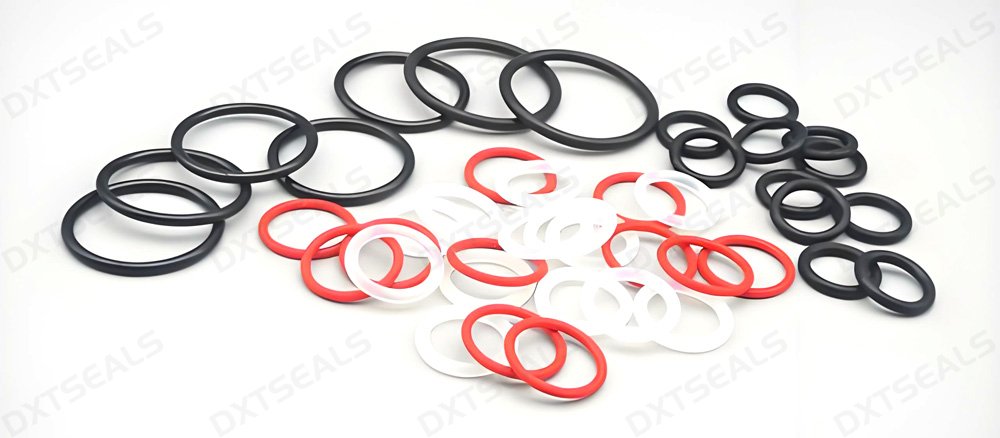Introduction
O-rings are among the most reliable and commonly used sealing solutions across various industries. They are designed to prevent leaks and provide a secure seal between two mating surfaces. While O-rings come in different shapes and sizes, the most critical aspect in selecting the right O-ring is choosing the correct material. The material affects the performance, durability, and overall success of the seal in different environments.
In this comprehensive guide, we’ll explore the key O-ring materials available, their advantages, and the factors you should consider when selecting the perfect O-ring material for your application.
Factors to Consider When Choosing O-Ring Materials
Before diving into the different types of materials, it’s essential to understand the factors that influence your decision when selecting an O-ring material:
- Temperature Resistance: O-rings may be exposed to both high and low temperatures. Ensuring the material can handle the required temperature range is crucial for effective sealing.
- Chemical Compatibility: The material should be compatible with the chemicals it will be exposed to in its environment.
- Mechanical Stress: Consider the amount of pressure, compression, and stress the O-ring will face during operation.
- Abrasion Resistance: Depending on the application, the O-ring may need to withstand constant friction or mechanical wear.
- Environmental Conditions: O-rings may be exposed to UV rays, ozone, moisture, or other environmental factors, so material resistance is key.
Now, let's explore the most commonly used materials for O-rings and their respective benefits.
1. Nitrile (Buna-N) O-Rings
Nitrile O-rings, also known as Buna-N, are one of the most common types of O-rings due to their versatility and cost-effectiveness. Nitrile is an elastomer material known for its excellent resistance to oils, fuels, and hydrocarbons, making it ideal for automotive, hydraulic, and fuel-related applications.
Key Benefits of Nitrile O-Rings:
- Oil and Fuel Resistance: Nitrile O-rings excel in sealing applications where oil, gasoline, and hydraulic fluids are involved.
- Good Abrasion Resistance: They offer resistance to wear and tear, ensuring long-term durability in dynamic applications.
- Temperature Range: Nitrile O-rings can typically withstand temperatures from -40°C to 100°C (-40°F to 212°F).
Applications:
Used widely in the automotive, fuel systems, aerospace, and hydraulic industries.
2. Silicone O-Rings
Silicone O-rings are known for their superior temperature stability and flexibility. These O-rings can endure extreme temperature conditions, making them an excellent choice for high-heat and low-temperature environments. Silicone is also highly resistant to ozone, UV rays, and oxidation.
Key Benefits of Silicone O-Rings:
- High-Temperature Resistance: Silicone O-rings can typically withstand temperatures ranging from -75°C to 250°C (-103°F to 482°F), making them ideal for applications involving heat.
- Low-Temperature Flexibility: Silicone remains flexible at low temperatures, which allows for effective sealing in cryogenic applications.
- Ozone and UV Resistance: Ideal for outdoor or exposed applications where weathering may be a concern.
Applications:
Commonly used in the food and beverage industry, medical devices, and HVAC systems.
3. EPDM O-Rings
EPDM (Ethylene Propylene Diene Monomer) O-rings are made from a synthetic rubber that is highly resistant to weathering, ozone, and aging. They also perform well in hot water and steam, making them suitable for plumbing and electrical insulation applications.
Key Benefits of EPDM O-Rings:
- Weather and Ozone Resistance: EPDM O-rings can endure harsh environmental conditions, including UV rays and ozone exposure.
- Good Water Resistance: EPDM performs well in water and steam applications, making it ideal for plumbing and HVAC systems.
- Temperature Resistance: EPDM O-rings can operate in temperatures between -50°C and 150°C (-58°F to 302°F).
Applications:
Used in automotive cooling systems, plumbing, HVAC, and electrical systems.
4. Fluorosilicone O-Rings
Fluorosilicone O-rings combine the benefits of silicone with enhanced chemical resistance. Fluorosilicone O-rings are highly resistant to oils, fuels, and solvents, making them an excellent choice for applications requiring chemical resistance at extreme temperatures.
Key Benefits of Fluorosilicone O-Rings:
- Superior Chemical Resistance: Fluorosilicone O-rings offer resistance to a wide variety of chemicals, fuels, and oils.
- High and Low-Temperature Resistance: They can function in extreme temperature ranges from -65°C to 200°C (-85°F to 392°F).
- Good Compression Set Resistance: These O-rings maintain their shape and sealing properties under pressure.
Applications:
Used in the automotive, aerospace, and military industries, where chemical exposure and temperature extremes are common.
5. PTFE (Teflon) O-Rings
PTFE O-rings are known for their high chemical resistance, non-stick properties, and low friction. PTFE is a synthetic fluoropolymer material often used in aggressive chemical environments or applications requiring low friction seals.
Key Benefits of PTFE O-Rings:
- Exceptional Chemical Resistance: PTFE O-rings resist a wide range of chemicals, including strong acids, bases, and solvents.
- High Temperature Tolerance: These O-rings can withstand temperatures ranging from -200°C to 260°C (-328°F to 500°F).
- Low Friction: PTFE O-rings reduce friction, making them ideal for dynamic sealing applications.
Applications:
Commonly used in chemical processing, food and beverage, and pharmaceutical industries.
6. Polyurethane O-Rings
Polyurethane O-rings are known for their high wear resistance, tensile strength, and ability to handle heavy-duty applications. They are an ideal choice for high-pressure and high-stress environments where durability is key.
Key Benefits of Polyurethane O-Rings:
- High Wear and Abrasion Resistance: Polyurethane O-rings can withstand high levels of friction and abrasion.
- High Tensile Strength: Ideal for heavy-duty applications, these O-rings can handle significant stress and pressure.
- Good Low-Temperature Flexibility: They perform well in low temperatures without losing flexibility.
Applications:
Widely used in hydraulic systems, heavy machinery, and automotive equipment.
Conclusion
Choosing the right material for your O-ring seals is essential to ensuring optimal performance, longevity, and reliability in your applications. Each material has its unique benefits that make it suited for specific industries, environmental conditions, and performance requirements.
Whether you need an O-ring for high-temperature, high-pressure, or chemically aggressive environments, selecting the appropriate material will help you achieve better sealing performance and prevent costly leaks and failures.
By considering the temperature range, chemical compatibility, and mechanical demands of your application, you can make an informed choice that guarantees the best possible sealing solution for your needs.

